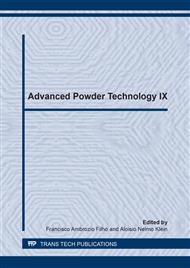[1]
K.J. Overshott: IEE Proceedings A, Vol. 138, (1991), pp.22-30.
Google Scholar
[2]
P. B. Hirsch. Herald of the Russian Academy of Sciences. Volume 76, (2006) , pp.430-436.
Google Scholar
[3]
F. A. Franco, M. F. R. González, M. F. de Campos, L. R. Padovese: Journal of Nondestructive Evaluation Vol. 32 ( 2013), pp.93-103.
Google Scholar
[4]
M. F. de Campos: Materials Science Forum Vol. 727-728 (2012), pp.157-162.
Google Scholar
[5]
T. Stijntjes, B. van Loon: Proceedings of the IEEE Vol. 96 (2008), pp.900-904.
Google Scholar
[6]
Marc J. de Vries, F. Kees Boersma: 80 Years of Research at the Philips Natuurkundig Laboratorium (1914-1994): The Role of the Nat. Lab. at Philips,. Pallas Publications, Amsterdam University Press, (2006).
DOI: 10.5117/9789085550518
Google Scholar
[7]
F. R. F. da Silva, F. A. Sampaio da Silva, C. G. Hauegen, S. R. Janasi, J. F. C. Lins, M. F. de Campos. In: H. Fukunaga, S. Sugimoto (Eds. ), Proceedings of the 22th International Workshop on Rare-Earth Permanent Magnets and Their Applications, Nagasaki, Japan, 2012, p.448.
DOI: 10.4028/www.scientific.net/msf.727-728.135
Google Scholar
[8]
M. F. de Campos, F. J. G. Landgraf: Materials Science Forum Vols. 498-499 (2005) pp.129-133.
Google Scholar
[9]
R. Szymczak, H. Szymczak and E. Burzo: IEEE Trans. Magn. Vol. MAG-23 (1987), p.2536.
Google Scholar
[10]
Wole Soboyejo. Mechanical Properties of Engineered Materials,. Marcel Dekker, CRC Press, New York, (2003).
Google Scholar
[11]
M. F. de Campos, F. A. Sampaio da Silva, E. A. Perigo, J. A. de Castro. Journal of Magnetism and Magnetic Materials, Vol. 345 (2013), pp.147-152.
DOI: 10.1016/j.jmmm.2013.06.028
Google Scholar
[12]
F. A. Sampaio da Silva, N. A. Castro, M. F. de Campos: Journal of Magnetism and Magnetic Materials Vol. 328 (2013), p.53–57.
Google Scholar
[13]
M.F. de Campos: Materials Science Forum, Vol. 591–593 (2008), p.8–12.
Google Scholar
[14]
M. F. de Campos: Materials Science Forum Vols. 530-531 (2006) pp.146-151.
Google Scholar
[15]
M. F. de Campos, S. A. Romero, F. J. G. Landgraf and F. P. Missell: Journal of Physics: Conference Series Vol. 303 (2011), p.012049.
Google Scholar
[16]
S.A. Romero, M.F. de Campos, H. Rechenberg and F. P. Missell: Journal of Magnetism and Magnetic Materials Vol. 320 (2008), p. e73-e76.
DOI: 10.1016/j.jmmm.2008.02.055
Google Scholar
[17]
M.F. de Campos: Materials Science Forum Vols. 660-661 (2010), pp.284-289.
Google Scholar
[18]
E.C. Stoner and E. P. Wohlfarth: IEEE Transactions on Magnetics Vol. 27(1991), pp.3475-3518.
Google Scholar
[19]
E. Kondorsky: Physik. Z. Sowjetunion Vol. 11 (1937), pp.597-620.
Google Scholar
[20]
D. V. Ratnam, W. R. Buessem: J. Appl. Phys. Vol. 43 (1972), pp.1291-1293.
Google Scholar
[21]
M.F. de Campos, J. A. de Castro: Materials Science Forum Vols. 660-661 (2010), pp.279-283.
Google Scholar
[22]
Y. Matsuura. In: H. Fukunaga, S. Sugimoto (Eds. ), Proceedings of the 22th International Workshop on Rare-Earth Permanent Magnets and Their Applications, Nagasaki, Japan, 2012, pp.147-150.
Google Scholar
[23]
Yutaka Matsuura, Jun Hoshijima, Rintaro Ishii: Journal of Magnetism and Magnetic Materials Vol. 336 (2013), p.88–92.
Google Scholar
[24]
A. Mager: Ann. Phys. Lpz. Vol. 11 (1952), p.15.
Google Scholar
[25]
R. Ramesh, G. Thomas and B. M. Ma: J. Appl. Phys. Vol. 64 (1988), p.6416.
Google Scholar
[26]
K. Uestuener, M. Katter, and W. Rodewald: IEEE Trans. Magn. Vol. 42 (2006), p.2897.
Google Scholar
[27]
M.F. de Campos, M. Emura, F.J.G. Landgraf: J. Magn. Magn. Mat. Vol. 304 (2006), p. e593.
Google Scholar
[28]
D. A. Porter, K. E. Easterling. Phase transformation in metals and alloys. 2nd Edition. 1992. Chapman & Hall London, New York.
Google Scholar
[29]
M.F. de Campos, J. A. de Castro: Materials Science Forum Vols. 727-728 (2012), pp.151-156.
Google Scholar
[30]
M.F. de Campos, J. A. de Castro: Materials Science Forum Vols. 727-728 (2012), pp.146-150.
Google Scholar
[31]
M.F. de Campos, F. J. G. Landgraf: Materials Science Forum Vols. 727-728 (2012), pp.169-174.
Google Scholar
[32]
E. Feldtkeller. Z. Angew. Phys. Vol. 19 (1965), p.530.
Google Scholar
[33]
C. R. Chang, C. M. Lee, J. S. Yang. Physical Review B Vol. 50 (1994) pp.6461-6464.
Google Scholar
[34]
S. Chikazumi: Physics of Ferromagnetism. (2nd Edition, Oxford University Press, Oxford New York, 2009).
Google Scholar
[35]
A. Aharoni: J. Appl. Phys. Vol. 51 (1980), p.3330.
Google Scholar


